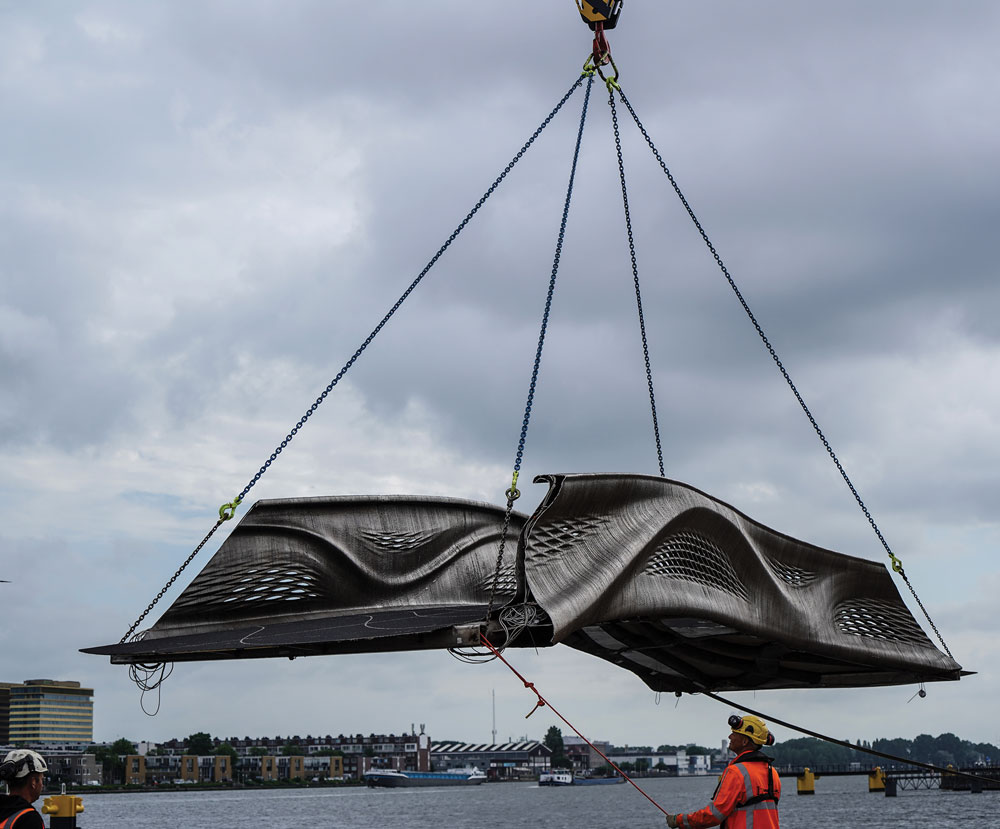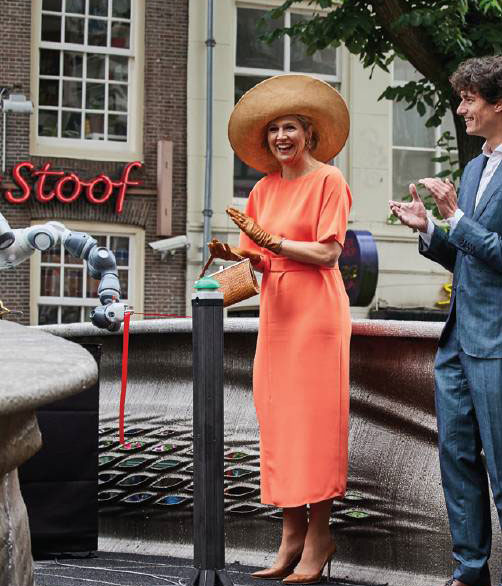3D Printing
Bridging the gap
The world’s first 3D printed steel bridge
The collaborative effort bringing a 3D printed steel bridge and its digital twin to life
THE world’s first stainless steel 3D printed bridge was unveiled in July 2021 in the city centre of Amsterdam. The futuristic multi-award-winning bridge, designed by Joris Laarman Lab with Arup as lead engineer, will be placed over Oudezijds Achterburgwal, one of the oldest canals in Amsterdam.

The bridge installed in Amsterdam city centre. ©Thea van den Heuvel.
The installation of the bridge is the culmination of several years of work. The project kicked off in 2015, when MX3D proposed printing a metal bridge with its innovative large-scale, robotic 3D printing technology, creating a playful, inspiring example of how digital tools can create a new form of language for architectural objects.
The project was brought to life thanks to funding from Lloyd’s Register Foundation and collaboration with ABB, Air Liquide, ArcelorMittal, Autodesk, AMS Institute and Lenovo.
Between 2017 and 2018, four robots 3D printed the structure using more than 6,000kg of stainless steel. The proprietary MX3D printing technology uses off-theshelf welding robots to build up metal objects layer by layer. The bridge design was created using generative design and topology optimisation techniques. The combination of those technologies allows for a higher form of liberty and a promise of significant material reduction.

Lifting the bridge into place. ©Merlin Moritz
Barriers and plot changes
Groundbreaking projects like this inevitably run into barriers and unexpected plot changes. The original design concept was changed considerably due to engineering concerns and printing on site was infeasible due to safety and technical concerns. In March 2017, the printing and assembly of large segments of the bridge began. Final placement had to be postponed nearly two years until the renovation of the canal walls was completed and all the formalities were ironed out.
In parallel MX3D engineers continued working on realising their vision of robots autonomously 3D-printing infrastructure. A robot was successful in triangulating its position and print while placed on the bridge. It validated the company’s vision and confirmed that robots printing bridges without human intervention is not science fiction anymore.
A living laboratory
The bridge serves as a living laboratory and is equipped with a state-of-the-art sensor network. In concert with academic and industry researchers, the City of Amsterdam will use the bridge’s data streams to explore the role of Internet of Things (IoT) systems in the built environment, such as anonymously analysing crowd behaviour to better understand the impact of tourism in the Red Light District.
The project also addresses questions about open data, data ethics, and citizen ownership of city analytics. For this purpose, the bridge was granted a two year permit by the City of Amsterdam.
Feeding the digital twin
Realising this vision required an extended collaboration between MX3D, The Alan Turing Institute, Arup, Autodesk, FORCE Technology, and the University of Twente. Between them, they have spent the last three years creating and installing the sensor network to enable real-time data collection to represent those data flows in live models, and to create usable analytics on top of that data which feeds into a digital twin of the bridge.

The bridge was opened by Her Majesty the Queen of the Netherlands, Máxima. ©Jan de Groen
The bridge’s sensors collect structural measurements such as strain, rotation, load, displacement and vibration, and also measure environmental factors such as air quality and temperature. Together, this data is used to create a digital twin, an accurate computer model that represents the physical bridge in real time.
The digital twin will help engineers measure the bridge’s health and monitor how it changes over its lifespan. The sensor data will also be used to ‘teach’ the bridge to understand what is happening on it, beginning with the ability to count how many people are crossing it and how quickly.
Having helped initiate the project in 2015, a team of researchers from Autodesk designed bespoke software and served as the primary systems integrator for the smart bridge. Software takes data from the sensor network and visualises it in a digital twin model representing the bridge’s response to use in real time.
Autodesk worked closely with the partners of the data centric engineering (DCE) programme at the Turing as well as FORCE Technology and the University of Twente to design and install the sensor network. Even in its prototype form, the network was useful when performing structural testing on the bridge.
Load testing and materials testing were both conducted by the DCE team, which proved that the bridge is able to hold at least a 19.5 ton load, well above its ultimate design load.
As the UK’s national institute for data science and artificial intelligence (AI), the Turing began its involvement with the bridge by assembling an interdisciplinary team of data science and AI experts from its DCE programme. The Turing is hosting the bridge data for the full two-year period covered by the bridge’s current operating permit and has conducted a thorough ethics review of the project to ensure that the scientific goals of the project do not compromise the privacy of the public.
Using a custom data platform, the Turing supports researchers who require access to the sensor data stored in its secure cloud.
The Turing researchers have expertise to develop novel and advanced digital twin models for prototypes of the MX3D bridge and are now applying these techniques to evolve the digital twin of the physical bridge as it is used.
Governmental support
As governments worldwide strive to build smarter cities, this valuable research project helps experts improve the design, operation and safety of future 3D printed structures and IoT systems under all conditions. As a key partner, the City of Amsterdam shows how local governments can act as facilitators in the introduction of new technologies.
Furthermore project BRIDE has now been funded by NWO (the Dutch research council) in which the University of Twente, TU Delft, Amsterdam Institute of Metropolitan Studies and MX3D will study the social side of a digital world.
This project will ask: What do citizens want from smarter infrastructures? Do they even want it? What are the ethical boundaries data collection should adhere to? Should a city collaborate or even be in the lead? How can we design the data sharing equitably?
Gijs van der Velden, CEO, MX3D
www.mx3d.com/bridge
The digital twin
A digital twin is a computer model that we can use to simulate something in the real world – be that a vehicle, a building, or an entire city. Analysing the model’s output tells us about the behaviour of the real thing, which can inform the real-world decisions we make about it. In this case, we’re modelling a 3D printed bridge. We have created a digital representation of the bridge’s structure, and sensors on the bridge feed into our model to tell us how the material is behaving, and how the bridge is being used.

Shipping the bridge into place. ©Merlin Moritz
The ‘real’ bridge
It’s a 12m long footbridge over the Oudezijds Achterburgwal canal in central Amsterdam, created by MX3D using robotic arms that deposit the steel layer-by-layer. This technique is completely automated and it gives greater precision and uses less steel than conventional methods.
It also gives engineers more control over the bridge’s shape, so that they can create features like these swooping curves. There’s a sign on the bridge explaining that it’s a research project and that we are collecting data. The data is anonymised; there are no privacy issues with the video recordings because the software automatically converts the pedestrians’ images into stick figures before any researchers access the recordings.
Sensors
We’ve got around 100 sensors in total, measuring the bridge’s load and how the bridge vibrates, bends and tilts as people cross it. We have sensors monitoring the temperature and humidity, as these will affect how the steel behaves, and we also have video cameras to record how people are using the bridge.
Data
The data from the sensors is wired to a server in the basement of a nearby building, where it’s uploaded to remote servers in the cloud. The team has developed software that uses this data to continuously update our computer model so that it’s as close as possible to the real thing.
We’ll use the model to analyse how the bridge is behaving, and look for any differences with our initial calculations.
This is the largest 3D printed metal structure in the world. It’s a new way of building, so we’re interested in finding out if the steel performs as we expect. We have lots of lab data, but this will be the first real-world test. Once we understand the material, we can look for new ways of building with it.
Video recordings
We plan to analyse the recordings to find out things like the number of people using the bridge and how long they stay there.
Will the bridge become a hub in the city where people hang out? Will tourists stop by and take selfies?
This all fits into the bigger picture of the smart city. If we have data on how citizens are using different areas and structures, the authorities can better plan the surrounding environment.
We know that pedestrian areas are a good place to put shops and cafés, for instance, because the businesses will benefit from the extra footfall. Data-collecting structures like this bridge will help planners to get a better idea of how they should be laying out their cities.
Future technology
Cities of the future could have an interconnected system of digital twins, where we can simulate how changes to one digital twin – such as a representation of the rail network or the water infrastructure – cascade through the system.
This could help authorities to predict problems before they even happen.
Collecting more data about our cities can also help us to push towards making them greener. If we have data on how carbon dioxide levels in the city decrease when we plant trees, or on how the local economy is benefiting from pedestrian areas, it helps make the case for adding more trees or pedestrian areas. Ultimately, the goal is to make our cities happier places to live, and data science has a crucial role to play.
Dr Eric Daub, Principal Research Data Scientist, The Alan Turing Institute
http://www.turing.ac.uk @turinginst



